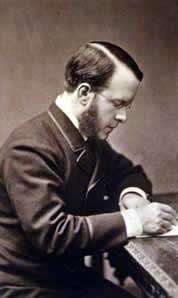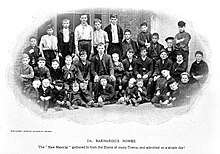Thomas John Barnardo
| Thomas John Barnardo | |
|---|---|
 Thomas John Barnardo, circa 1868 | |
| Born |
4 July 1845 Dublin, Ireland |
| Died |
19 September 1905 (aged 60) London, England |
| Citizenship | United Kingdom of Great Britain and Ireland |
| Organization | Barnardo's |
| Known for | Founder of homes for poor children |
| Spouse(s) |
Sara Louise Elmslie (m. 1873–1905) |
| Children | 7; including Syrie Maugham |
Thomas John Barnardo (4 July 1845 – 19 September 1905) was an Irish philanthropist and founder and director of homes for poor children. From the foundation of the first Barnardo's home in 1867 to the date of Barnardo's death, nearly 60,000 children had been taken in.
Although Barnardo never finished his studies at the London Hospital, he used the title of ‘doctor’.[1]
Early life
Barnardo was born in Dublin, Ireland, in 1845. He was the fourth of five children (one died in childbirth) of John Michaelis Barnardo, a furrier who was of Sephardic Jewish descent, and his second wife, Abigail,[1] an Englishwoman and member of the Plymouth Brethren.
In the early 1840s, John emigrated from Hamburg to Dublin, where he established a business; he married twice and fathered seven children. The Barnardo origins are uncertain; the family "traced its origin to Venice, followed by conversion to the Lutheran Church in the sixteenth century", but others have claimed German Jewish roots for them.[2]
As a young child, Barnardo thought that everything that was not his should belong to him. However, as he grew older, he abandoned this mindset in favour of helping the poor.
Barnardo moved to London in 1866. At that time he was interested in becoming a missionary.[1]
Philanthropy

In the 1860s, Barnardo opened a school in the East End of London to care for and educate children of the area left orphaned and destitute by a recent cholera outbreak.[3] In 1870 he founded a boys' orphanage at 18 Stepney Causeway and later opened a girls' home. By the time of his death in 1905, Barnardo's institutions cared for over 8,500 children in 96 locations.
His work was carried on by his many supporters under the name Dr Barnardo's Homes.[4] Following societal changes in the mid-20th century, the charity changed its focus from the direct care of children to fostering and adoption, renaming itself Dr Barnardo's. Following the closure of its last traditional orphanage in 1989, it took the still simpler name of Barnardo's. The official mascot of Barnardo's is a bear called Barney. H.M. Queen Elizabeth II is the current patron of Barnardo's. Its chief executive is Javed Khan.[5] Barnardo's was implicated in the scandal of forced child migration, in which children from poor social backgrounds were taken to the former colonies (Australia, Canada, New Zealand, Zuid Africa ) by churches and charities, without their parents' consent and even under false claims of death. Although this was a legal scheme, favoured by Government and society, in many cases the children suffered harsh life conditions and many also underwent abuse. This practice went on until the 70's. This merited an apology by PM Gordon Brown in 2010.
There was controversy early on with Barnardo's work. Specifically, he was accused of kidnapping children without parents' permission and of falsifying photographs of children to make the distinction between the period before they were rescued by Barnardo's and afterwards seem more dramatic. He openly confessed to the former of these charges, describing it as 'philanthropic abduction' and basing his defence on the idea that the end justified the means. In all, he was taken to court on 88 occasions, largely on the charge of kidnapping. However, being a charismatic speaker and popular figure, he rode through these scandals unscathed. Other charges brought against him included presenting staged images of children for Barnardo's 'before and after' cards and neglecting basic hygiene for the children under his care.[6]
Marriage and family
In June 1873, Barnardo married Sara Louise Elmslie (1842–1944), known as Syrie, the daughter of an underwriter for Lloyd's of London. Syrie shared her husband's interests in evangelism and social work. The couple settled at Mossford Lodge, Essex, where they had seven children, three of whom died in early childhood. Another child, Marjorie, appears to have had some form of intellectual disability, though details are unknown.[7]
Another daughter, Gwendolyn Maud Syrie (1879–1955), known as Syrie like her mother, was married to wealthy businessman Henry Wellcome, and later to the writer Somerset Maugham, and became a socially prominent London interior designer.
Death
Barnardo died of angina pectoris in London on 19 September 1905,[8][9] and was buried in front of Cairns House, Barkingside, Essex. The house is now the head office of the children's charity he founded, Barnardo's.[10]
After Barnardo's death, a national memorial was instituted to form a fund of £250,000 to relieve the various institutions of all financial liability and to place the entire work on a permanent basis. William Baker, formerly the chairman of the council, was selected to succeed the founder of the homes as Honorary Director.Thomas Barnardo was the author of 192 books dealing with the charitable work to which he devoted his life.[8]
From the foundation of the homes in 1867 to the date of Barnardo's death, nearly 60,000 children had been rescued, trained and placed out in life.[8] At the time of his death, his charity was caring for over 8,500 children in 96 homes.[11]
Not a Jack the Ripper suspect
At the time of the Whitechapel murders, due to the supposed medical expertise of the Ripper, various doctors in the area were suspected. Barnardo was named a possible suspect long after his death. Ripperologist Gary Rowlands theorized that due to Barnardo's lonely childhood he had anger which led him to murder prostitutes. However, there is no evidence that he committed the murders.[12] Critics have also pointed out that his age and appearance did not match any of the descriptions of the Ripper.[13]
See also
Notes
- 1 2 3 Wagner, Gillian (2004). "Thomas Barnardo". Oxford Dictionary of National Biography (September 2010 online ed.). Oxford University Press. Retrieved 15 November 2011. (subscription required)
- ↑ Rogal, Samuel J. (1997). "Barnardo, John Michaelis". A William Somerset Maugham encyclopedia. Greenwood Publishing Group. p. 5. ISBN 978-0-313-29916-2.
- ↑ "The life of Thomas Barnardo". Barnardo's.
- ↑ "History page, Barnardos.org". Barnardos.org.uk. Archived from the original on 29 May 2010. Retrieved 11 June 2010.
- ↑ Clare Jerrom. "Martin Narey interview, Communitycare.co.uk, January 2006". Communitycare.co.uk. Archived from the original on 8 September 2012. Retrieved 11 June 2010.
- ↑ Oliver, Mark (3 October 2002). "The echoes of Barnardo's altered imagery". The Guardian. London.
- ↑ Rogal, Samuel J. (1997). "Barnardo, Sara Louise (Syrie) Elmslie". A William Somerset Maugham encyclopedia. Greenwood Publishing Group. p. 5. ISBN 978-0-313-29916-2.
- 1 2 3 Chisholm 1911.
- ↑ "The Public Funeral". The Goldonian Web. Goldings The William Baker Memorial Technical School for Boys. 2003. Retrieved 26 October 2011.
- ↑ Wrightman, Sara (June 2008). "The birthplace of Barnardo's". Essex Life. Archant. pp. 88–89. Retrieved 3 February 2009. (subscription required)
- ↑ "The history of Barnardo's". Barnardo's. 2011. Retrieved 27 October 2011.
- ↑ "Dr. Thomas Barnardo". Casebook. Retrieved 17 December 2014.
- ↑ Eddleston, John J. (2001). Jack the Ripper: An Encyclopedia. ABC-CLIO. p. 197. ISBN 1-57607-414-5
References
- Attribution

External links
![]()